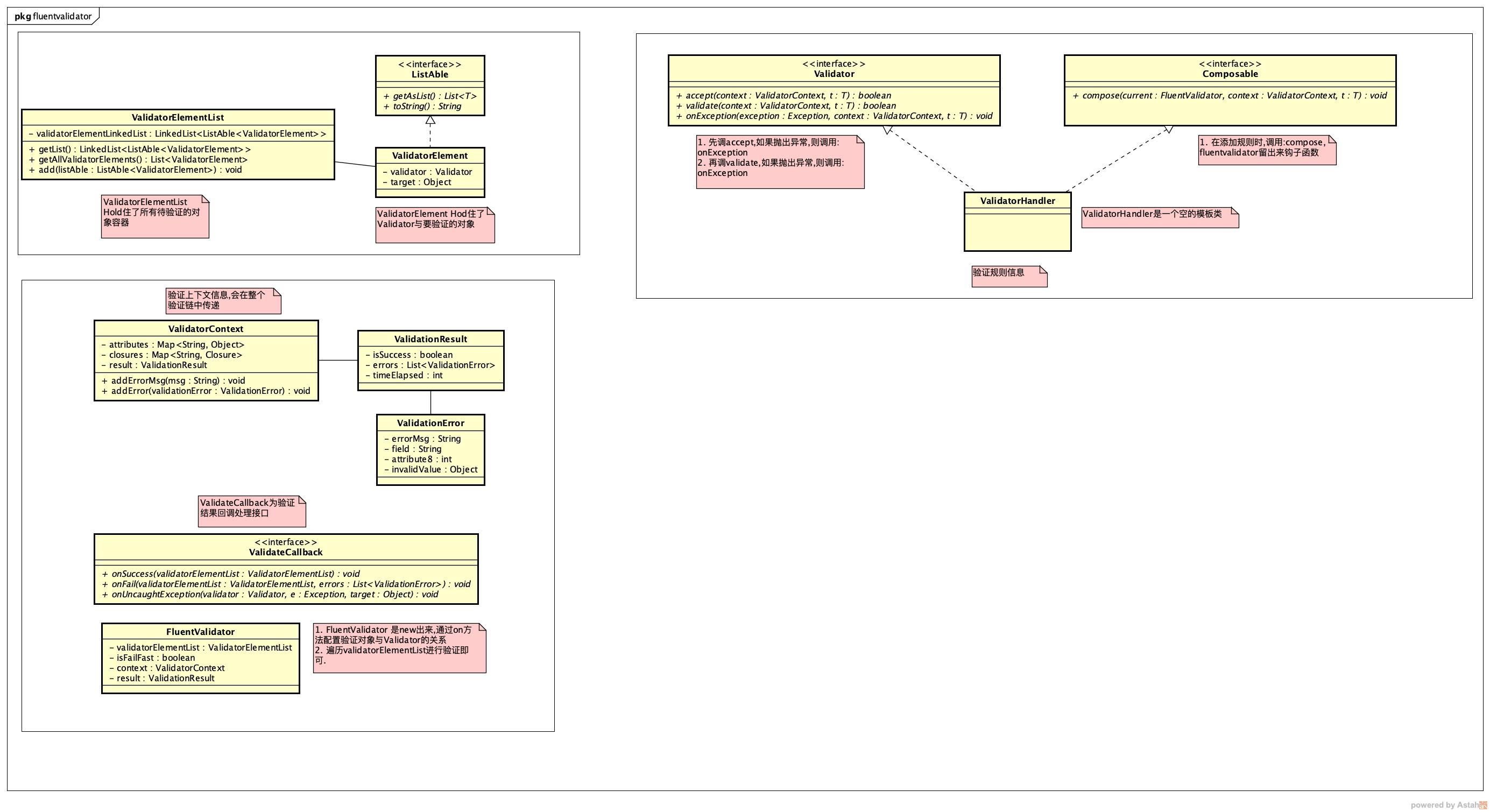(1). 概述
在这里主要对FluentValidator进行剖析.
(2). 看下FluentValidator类图

(3). FluentValidator使用
FluentValidator
// *****************************************************
// 4. 创建FluentValidator对象
// *****************************************************
.checkAll()
// *****************************************************
// 5. FluentValidator进行验证时,验证不通过直接退出,不再继续对其它对象进行验证了
// *****************************************************
// 验证规则不通过时,立即返回,不再进行后续的验证了
.failFast()
// *****************************************************
// 6. 配置验证对象与验证规则的关系
// *****************************************************
.on(car.getSeatCount(), new CarSeatCountValidator()) //
// *****************************************************
// 7. 开始验证,并回调
// *****************************************************
.doValidate(callback);
(4). FluentValidator.checkAll
public static FluentValidator checkAll() {
return checkAll(null);
}
public static FluentValidator checkAll(Class... groups) {
// 创建了一个:FluentValidator对象
return new FluentValidator().setGroups(groups);
}
(5). FluentValidator.failFast
public FluentValidator failFast() {
this.isFailFast = true;
return this;
}
(6). FluentValidator.on
public <T> FluentValidator on(T t, Validator<T> v) {
Preconditions.checkNotNull(v, "Validator should not be NULL");
// 1. 如果Validator属于:ValidatorHandler,则调用:ValidatorHandler.compose
composeIfPossible(v, t);
// 2. 创建:ValidatorElement Hold住:验证规则(Validator)和验证对象(属性)
// 3. 添加到:validatorElementList里
doAdd(new ValidatorElement(t, v));
lastAddCount = 1;
return this;
} // end on
private <T> void composeIfPossible(Validator<T> v, T t) {
final FluentValidator self = this;
if (v instanceof ValidatorHandler) {
((ValidatorHandler) v).compose(self, context, t);
}
} // end composeIfPossible
(7). FluentValidator.doValidate
public FluentValidator doValidate(ValidateCallback cb) {
Preconditions.checkNotNull(cb, "ValidateCallback should not be NULL");
// 1. 如果待验证的列表为空,则直接返回
if (validatorElementList.isEmpty()) {
LOGGER.debug("Nothing to validate");
return this;
}
// 2. 给上下文设置一个默认的:result
context.setResult(result);
// 打印日志
LOGGER.debug("Start to validate through " + validatorElementList);
long start = System.currentTimeMillis();
try {
// ThreadLocal设置groups
GroupingHolder.setGrouping(groups);
// ************************************************************
// 3. 遍历所有的验证规则集合
// ************************************************************
for (ValidatorElement element : validatorElementList.getAllValidatorElements()) {
// 4. 要验证的对象
Object target = element.getTarget();
// 5. 验证的规则
Validator v = element.getValidator();
try {
// *******************************************************
// 6. 先调用:Validator.accept,只有为:true时,才调用:validate
// *******************************************************
if (v.accept(context, target)) {
// *******************************************************
// 7. 再调用:Validator.validate
// *******************************************************
if (!v.validate(context, target)) { //验证不通过时
result.setIsSuccess(false); // 设置验证不通过
if (isFailFast) { // 如果:isFailFast为true,跳出循环体,不再进行余下的验证了
break;
}// end if
} // end validate
} // end accept
} catch (Exception e) {
try {
// *****************************************************
// 8. 有异常时,调用:Validator.onException
// *****************************************************
v.onException(e, context, target);
// 9. 回调:ValidateCallback
cb.onUncaughtException(v, e, target);
} catch (Exception e1) {
if (LOGGER.isDebugEnabled()) {
LOGGER.error(v + " onException or onUncaughtException throws exception due to " + e1
.getMessage(), e1);
}
throw new RuntimeValidateException(e1);
}
if (LOGGER.isDebugEnabled()) {
LOGGER.error(v + " failed due to " + e.getMessage(), e);
}
throw new RuntimeValidateException(e);
}
}
if (result.isSuccess()) { // 验证成功,回调:ValidateCallback.onSuccess
cb.onSuccess(validatorElementList);
} else { // 验证失败,回调:ValidateCallback.onFail
cb.onFail(validatorElementList, result.getErrors());
}
} finally {
// 清除ThreadLocal信息
GroupingHolder.clean();
// 计算验证的成本
int timeElapsed = (int) (System.currentTimeMillis() - start);
LOGGER.debug("End to validate through" + validatorElementList + " costing " + timeElapsed + "ms with "
+ "isSuccess=" + result.isSuccess());
result.setTimeElapsed(timeElapsed);
}
return this;
}
(8). 总结
好像没什么要总结的,FluentValidator源码相当的简单!
